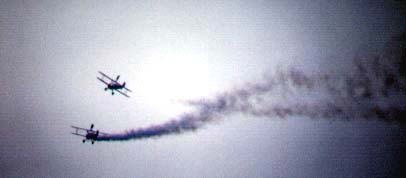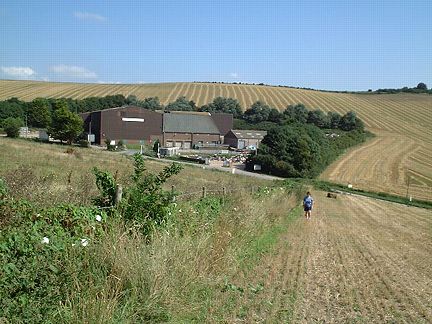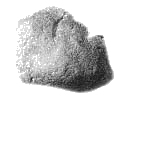
|
NEWS BULLETIN FOR THE ADUR VALLEY |
| News & Events |
| Wildlife Reports |
| Words of the Week |
| Advertisements |
If
you wish to receive this Bulletin, please ask by EMail, specifying the
Adur
Torpedo with your full name.
Glaucus@hotmail.com |
| Web Sites (Local) |
| Poem |
| Computer Tips |
| Games & Leisure |
| Web Sites (****) |
| Events |
|
|
| Adur
"World Oceans Day"
SLIDE SHOW 2000 |
 |
| Wildlife Web Sites |
 |
| LOCAL
ORGANISATIONS |
| LOCAL RESIDENTS PAGE |
|
|
|
|
|
|
|
|
|
|
|
|
|
|
|
|
|
|
|
|
|
|
|
|
|
|
|
|
|
|
|
|
|
|
|
|
|
|
|
|
|
|
|
|
|
|
|
|
|
|
|
|
|
|
|
|
|
|
|
|
|
|
|
|
|
|
|
|
|
|
|
|
|
|
| 55 | 56 | 57 |
| 58 |
|
|
| 61 |
|
|
|
|
|
|
|
|
|
|
| 70 | 71 | 72 |
This is the first published
Electronic Newspaper for
Shoreham-by-Sea and the
Adur Valley & District, West Sussex, England
Local News1 & 2 September 2001
BATTLE OF BRITAIN AIR SHOW
at Shoreham Airport
South Downs National Park : Proposed Area
http://www.countryside.gov.uk/reception/papers/Areaofsearchmap.jpgClick on the URL for the complete map
West Sussex County Council announce most paths are now open, unless they are inhabited or used by farm livestock, or farm animals are nearby.
The cycle path from Old Shoreham is officially open.
Please send any comments to: Andy Horton
Glaucus@hotmail.com
Wildlife Notes28 August 2001
The small brown dragonfly on the path to the Waterworks Road at the steps down in the south-west corner (TQ 209 063) was noted because of its dark green head, and a red fringe on one wing and black on the other pair of wings. It was probably a Common Darter Dragonfly, Sympetrum striolatum.
A faded (dull coloured) Small Tortoiseshell Butterfly settled briefly, as did a Speckled Wood and a handful of Red Admirals.27 August 2001
On the edge of the arable field next to Halewick Lane, Lancing, a handful of small brownish butterflies flit past. I was only able to identify the species as the Small Heath, Coenonympha pamphilus, after consulting the reference book. The eyespots and the small size make it unmistakable.
The adjoining field is covered in a mass of tall and short wild plants that have settled in since the topsoil was replaced over the landfill that once occupied this land. The mix of plants is nothing like that would normally cover downland, it more resembles colonisation of a derelict building site.
Halewick Report by Ray HamblettEarlier Reports of Small Heath
Butterflies of Lancing27 August 2001
After Sunday's thunderstorms, the sun came out for Bank Holiday Monday and it was pleasant rather than stifling hot and humid of last week. When I did not have a film in my camera, all the butterflies and dragonflies stayed still and posed.
On the footpath from the Waterworks Road (southern end) to (TQ 209 063) to Mill Hill, a Red Admiral and Painted Lady Butterfly stayed stationary for minutes at a time.
But this was not as long as a large darter butterfly, which because of its size, I thought it was an Emperor Dragonfly, but I think it was a Southern Hawker. The abdomen seemed to have a permanent bend in it as it remained stationery for long enough to take a whole roll of film if there was any in the camera. Emperor Butterflies seem to be always on patrol, and can fly quite high as well.25 August 2001
The emerald-green Grasshopper that was in the Buckingham Arms, Shoreham tonight was probably the Common Green Grasshopper, Omoecestus viridulus, not the common grasshopper from the meadows south of Lancing Ring which was probably the Common Field Grasshopper, Chorthippius brunneus.

Common Field Grasshopper, Chorthippius brunneus.
(naturally damaged before collection for the photograph)Thanks for Katherine Hamblett for catching the grasshoppers in the meadow. But the one in the Buckingham would not let go. It seemed to like me. I let it go outside on the flowering plants in the baskets. The Common Green Grasshopper is a strong flier which would explain its occurrence in Shoreham town.
Grasshoppers are only active in warm weather.
August 2001
I have identified this dragonfly discovered by Allen Pollard at Shermanbury as the Southern Hawker, Aeshna cyanea. It looks a bit like the female Emperor Dragonfly, Anax imperator.
Earlier Report
Shermanbury Bug Reports and Photographs
British Dragonfly Society Species Checklist23 August 2001
Wheatears, fly to and from over the shingle beach between Widewater Lagoon and the sea, their white rear very distinctive, before this slim bird settles prior to its long migration back to Africa for the winter months. Three birds were seen by the beach huts. There were probably more.
A few Red Admiral Butterflies appeared to flutter in from the seaward side, but these butterflies are strong flyers and they may be just be moving from one nectareous plant to another.
Coastal ShorehamIt was early evening, (7:30 pm with reasonable light) In Dolphin Road, Shoreham, (TQ 224 055) a very small (scarcely bigger than a thrush) bird of prey dived headlong into the bramble bush right next to me as I cycled past. There was no further commotion as the speckled breast bird with a grey and brown underwing (strongly banded) rose from the bush and rested, silhouetted, on the roof of the house on the opposite side of the road. After a wait of over a minute, it disappeared flying as straight as an arrow. I think this was a juvenile Kestrel, behaving like a Sparrowhawk as they tend to in the autumn.
20 August 2001
20 August 2001
The long spring tide went out below Chart Datum on Kingston beach and there was a meal of large prawns Paleamon serratus. The presence of a dozen very small Common Starfish, Asterias rubens, was unusual for this particular shore. There was an interesting mixture of typical fish and invertebrate intertidal life, with hundreds of very small (30 - 55 mm) first year Bullheads. Medium-sized Butterfish, Five-bearded Rocklings, Sand Gobies, with a few of each (up to five recorded) and at least one Eel, Anguilla, under a boulder were the rock pool fish of note. Common Hermit Crabs, Long-legged Spider Crabs, Long-clawed Porcelain Crabs, Hairy Crabs, represented the crab fauna, with the Shore Crab, common, of course. One or two Shore Crabs were dead and being consumed by hundreds of Netted Dogwhelks.
Molluscs (BMLSS)19 August 2001
Juvenile Five-bearded Rocklings, young (first year) Corkwing Wrasse, small Bullheads and very small Squat Lobsters Galathea squamifera, on the middle shore on the low springs that did not go out far in a blustery breeze (Force 4).
Zonation on the Shore
Intertidal (Seashore)
18 August 2001
Brianne Reeve led the Butterfly Conservation Society walk at Lancing Ring. The day was overcast and later it began to rain. On my cycle route on the path from the Coombes Road before the Chalk Pits to the Mill Road car park I spotted a Wall Brown Butterfly.
The route we followed was through Pat Barton's Wood to the Hay Meadow. There were few butterflies to be seen so Brianne Reeve mentioned some of the flowers in the field including the omnipresent Wild Parsley, Wild Carrot, Dogwood. Mugwort, Herb Basil, Red Bartsia, and the Hardhead (the smaller of the Knapweeds, more thistle-like superficially) Centaurea nigra.
A Speckled Wood and a Gatekeeper Butterfly, both in good condition obliged by opening on the same bramble bush. In the long grass meadows, the day was overcast so the only way about a hundred each of small Common Blue Butterflies and Meadow Browns could be revealed was by flushing them out with the attendant risk of stepping on some of them, or more likely stepping on the moths at the bottom of the long grasses.A Green Shield Bug, Palomena sp, was discovered by Katherine Hamblett. This little bug is very noticeable because of its shield shape and bright green colour. The usual species is Palomena prasina, common on Hazel trees, but there are others.
Tip from Brianne Reeve: The Large White has a greater amount of black border on its wing than the Small White.
Brianne Reeve recommended the out of print pocket guide "Butterflies" by Martin A. Thomas in the RSNC issue. There is also a Hamlyn guide by the same author.
Butterflies of Lancing
Butterfly Plants "Smart Group"
Friends of Lancing Ring
Butterfly Guide
17 August 2001
As the Harrier Jump-jet roared overhead, in the meadows amongst the scrub on Mill Hill, the Common Blue Butterfly was common (100+) clinging, wings folded, to the stems of long grasses and wild plants, to rise fluttering in the late summer evening when disturbed. The females are smaller, brown, decorated with distinctive orange spots on the upperside. There were a few Chalkhill Blues as well, some a bit battered and old, others fresher, as well as the omnipresent Meadow Browns, but also some strongly flying Wall Brown Butterflies.
Blue Butterflies (photographs)
UK-LEPS Discussion Group (for Butterflies and Moths)
Adur Butterflies
Poem or LiteratureSize and function are the essential ingredients of character
Running through all problems of conservation there is therefore the fundamental problem of population growth. The essence of' the character of most towns is the town centre embodying both the social and commercial life of the town. The number of people which that centre must serve the size of population will determine its ability to sustain a conservation policy.
There are two kinds of population growth: immigrant growth and natural growth. The first is to some extent controllable.
These static towns attract people who have a strong interest in retaining the identity of the place.
But an increase in population does not bring a guaranteed long term advantage.
from "Character of Towns" by Roy Worskett (Architectural Press 1969)
SBN 85139 121 4
- Wildlife
Web Sites
Hoverflies
of the UK
Common
Dragonflies and Damselflies (photographs)
British
Dragonfly Society Species Checklist
Butterflies
of Lancing
Adur
Butterfly Page
Shermanbury
(Adur Valley)
Butterfly
Conservation Society
UK-Leps
eForum (Lepidoptera)
Wildlife
& Conservation Links (West Sussex)

Freshwater Life of North-western Europe EFORUM PAGE |
The British Marine Life Study Society has an alternative web site address for its Homepage only:
1 August
2000
The
Marine Wildlife of the North-east Atlantic (formerly
the British Marine Wildlife Forum)
***** commences.
PLEASE
JOIN

MARINE WILDLIFE of the NORTH-EAST ATLANTIC EFORUM PAGE |
http://groups.yahoo.com/group/ukwildlife

UK Environment and Planning EFORUM PAGE |
British
Naturalists' Association (link)
Find
the Sites of Special Scientific Interest using this link:
Friends
of the Earth SSSI Navigator
- Words
of the Week
epistemology | pstmldi, e- | n. M19. [f. Gk epistemo- comb. form of episteme knowledge, f. epistasthai know (how to do) + -OLOGY.] The branch of philosophy that deals with the varieties, grounds, and validity of knowledge.epistemological a. L19. epistemologically adv. in an epistemological manner; with reference to epistemology: L19. epistemologist n. L19.
gambol
| amb()l | n. & a. Also (earlier) -old. M16. [Alt. of GAMBADE.]
A n. 1 A caper, frisk, or frolic, esp. of a child or an animal; a playful
action. Usu. in pl. M16. 2 A toy, a plaything. L16-M17.
1
SHAKES. Wint. T. A dance which the wenches say is a gallimaufry of gambols.
S. RICHARDSON A silly poor girl, set up by the gambol of fortune for a
May-game.
B
attrib. or as adj. Playful, sportive. L16-M17.
gambol
| amb()l | v.i. Infl. -ll-, US-l-. Also (earlier) -old. E16.
[f. as prec., after Fr. gambader.] Leap or spring in dance or play; frolic.
W.
GOLDING The rats jumped and gambolled and played on the mud beach.
galumph
| lLmf | v.i. L19. [Portmanteau
word combining gallop and triumph, coined by Lewis Carroll in Through the
Looking-Glass.] Orig., advance exultantly with irregular bounds. Now chiefly,
move in a noisy, ponderous, or clumsy way. Freq. as galumphing ppl a.
D.
LODGE Shrieking and gaspingthey galumphed across the yard. transf.: D.
WILKINSON The statementmaygive the impression that atoms are large, ungainly
galumphing things.
gin | dn | n.1 ME. [Aphet. f. OFr. engin ENGINE n.] 1 Skill, ingenuity. Also, cunning, craft, artifice. ME-L15. 2 A scheme, a device; a trick. ME-E18. 3 a An instrument, a tool. ME-E17. b A mechanical contrivance or device, a machine. arch. LME. 4 A contrivance for catching game etc.; a snare, a net, a trap. ME. 5 An instrument of torture; spec. the rack. ME-L16. 6 A military machine for hurling stones or other missiles. ME-M16. 7 A device for fastening a door or window; a bolt, a bar. obs. exc. dial. ME. 8 a A hoisting apparatus; spec. a three-legged crane or derrick. LME. b Mining. A horse- or wind-powered windlass for pumping, lifting, etc. L17. 9 A machine for separating cotton from its seeds. M18. 10 Naut. An all-metal tackle block with a skeleton frame. M19.
---------------------------------------------------------
Excerpted
from The Oxford Interactive Encyclopedia
Developed
by The Learning Company, Inc. Copyright (c) 1997 TLC Properties Inc.
- Star: Latest Virus Information

Small Publisher EFORUM PAGE |
Computing
Net Support Site
(for computing problems) ****
http://computing.net/windows95/wwwboard/wwwboard.html
The upsurge of EFora
on all subjects (a
few have been recommended before in these bulletins) are an important way
in which the Internet
will change the world.
A list of recommended eFora
will appear soon. Please make any suggestions.
See the Profusion Search method below.
- Archaeology
in Sussex to AD 1500 ****
WSCC
LIBRARY *****
Excellent
and essential service with a full catalogue of books, CDs, videos,
on-line renewals, book ordering.
- The
Glaucus 2000 CD-ROM includes the complete Shoreham-by-Sea
and Adur Valley web sites, as well as shareware
and free programs
Sussex
& the Downs Discussion Group (with new images of Sussex)

ADUR VALLEY EFORUM PAGE |
 |
Brief History of Shoreham-by-Sea
Sussex Archaeological Society
http://www.sussexpast.co.uk
Sussex Archaeological Society
http://www.sussexpast.co.uk
SUSSEX
PAST
Sussex
Archaeological Society EGroup
Events
- Adur
On-line Events page
- http://appspace.nexus-solutions.net/arc/asp/diary/diaryoutput.asp
- Please send in any details of local events.
- Web
Sites
American
Heritage Dictionary of the English Language:
Fourth
Edition *****
- SPONSORSHIP OPPORTUNITY
For any company or organisation wanting nationwide green publicity, there is an opportunity to sponsor the journal "Glaucus" of the British Marine Life Study Society.
There remains sponsorship opportunities on the BMLSS (England) web site and other publications, including Torpedo.
Sponsorship is also available for the Adur Torpedo Electronic News Bulletin and the Shoreham-by-Sea web pages (which preceded the Adur Resource Centre web site), which would be more suitable for a local firm(s).
Web Site Design Services are available from Hulkesmouth Publishing
Normal
advertisement rules apply.
Submissions
accepted by EMail only.
Adur
Torpedo was written, designed and distributed by Andy
Horton.





